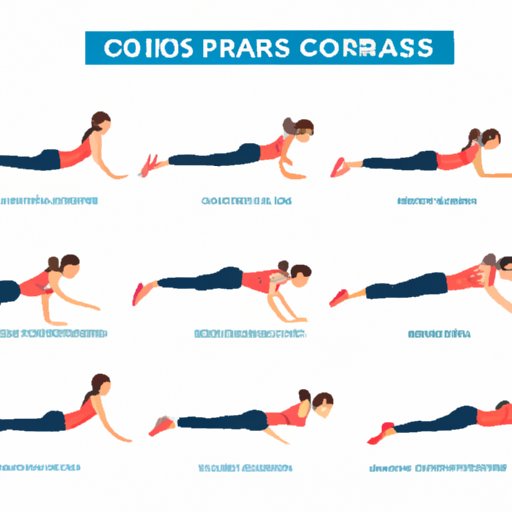
I. Introduction
Planks are one of the most effective exercises for strengthening your core muscles. This simple bodyweight exercise can be done anywhere and can help improve posture, relieve back pain, and increase flexibility. In this article, we will break down the basics of planking form and techniques, explore the different benefits and variations of planks, and provide tips for improving your plank game.
II. The basics
Before diving into the different variations of planks, it is essential to get down the correct form and technique for a traditional forearm plank. Ensure you are lying on your stomach with your forearms flat on the ground, shoulder-width apart, and your toes tucked in. Push your body up so that your back is straight and your weight is evenly distributed between your forearms and toes. Your body should form a straight line from your head to your heels.
Engage your core muscles and squeeze your glutes to maintain form. Breathe steadily, inhaling and exhaling deeply, and avoid holding your breath. Begin with a modest hold time of 10-20 seconds and gradually increase to one minute or more, depending on your experience level.
If you’re struggling with the traditional plank or need to modify it, there are several ways to do so. For instance, you could try the high plank by starting on your hands instead of your forearms. Alternatively, you could lower your knees to the ground and attempt a knee plank. No matter what level you’re at, there’s a plank for you.
III. Benefits and variations
Besides being a great core workout, planks also offer many other benefits. Planks can help to improve balance and posture, reduce back pain, and even reduce the risk of back injuries. Additionally, planking can strengthen your hips, glutes, shoulders, and neck, and improve flexibility.
There are also many different variations to the plank that target different areas of the body. The side plank targets the obliques and hips by having the body supported by one forearm and the sides of the feet. The elbow plank is similar to a traditional plank but performed on your elbows, challenging your core strength. The reverse plank targets your lower back and glutes by having your weight supported on your hands and heels with your belly facing up.
IV. How to make planks more challenging
Once you’ve mastered the basics, you can increase the intensity of your plank by adding a weight, increasing the hold time, or changing positions. Adding weight, such as wearing a weighted vest or placing a plate on your back, will place more resistance on your core muscles and increase the difficulty. Increase the hold time of your plank to train your muscles’ endurance, and changing your position, such as lifting your leg or arm when doing a traditional plank, will challenge your balance and core strength even more.
V. Combining planks with other exercises
Planks can also be combined with other exercises to create a full-body workout. For example, adding planks to a pushup or burpee routine can enhance your overall strength and endurance. Planks can also be incorporated as part of a full-body workout routine, such as yoga or pilates, to target different areas of the body and improve flexibility.
VI. Planks for specific purposes
Planks can be useful for improving sports performance, rehabilitation after an injury, and even building yoga strength. For athletes, planking can help improve their posture, balance, and core strength, which can help enhance their overall performance. For those rehabilitating from the injury, planking can help strengthen and stabilize the muscles around the injured area and help expedite the recovery process. Lastly, combining planks with yoga can help you build your body’s overall strength, especially your core muscles, which is essential to practicing yoga safely.
VII. Common mistakes to avoid
Like any exercise, planking can cause injuries if not performed correctly. The most common mistake people make while planking is arching their back, which can cause pain or strain your lower back muscles. Holding your breath during a plank can also put unnecessary stress on your body. Finally, placing your hands far apart can create instability and lead to shoulder pain.
VIII. Fun variations and challenges
If you’re looking for more challenging ways to plank, there are many fun variations and challenges you can try. The walking plank involves moving your arms and legs like you’re walking while maintaining a plank position. Plank jacks are plyometric exercises that target your calves and quads. Finally, the plank-to-pike is an advanced variation that targets the abs and shoulders.
IX. Conclusion
Planks offer many benefits and are an excellent exercise to add to your fitness routine. Whether you’re looking to improve your posture, increase your core strength, or rehab an injury, planks are a versatile and practical way to do so. By following the tips and techniques outlined in this article, you can perfect your form and take your plank game to the next level.




